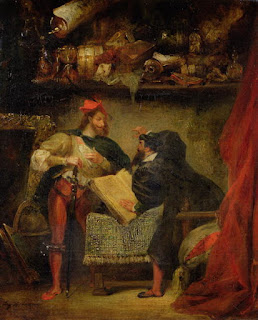Model uncertainty: the Economist and the Evil agent
Introducing “Doubts and Variability” by Rhys Bidder (Federal
Reserve Bank of San Francisco) and Matthew E. Smith (Federal Reserve Board).
Working Paper (First Draft Sept 4, 2010 – current
version Aug 4, 2011).
One of the most enduring puzzles in the macrofinance
literature is the equity premium puzzle. A manifestation of this puzzle is the
difficulty of designing a model that simultaneously generates a substantial
market price of risk and a low risk free rate, while also respecting stylized
facts regarding consumption dynamics, as discussed by Hansen and Singleton
(1982) and Mehra and Prescott (1985).
In this paper Bidder and Smith show that the
interaction of stochastic volatility in consumption with a fear of model
misspecification can bring new pieces to the puzzle.
The agent in their heteroskedastic (with time-varying
variance) endowment economy does not fully trust the joint conditional distribution
of the volatility process and consumption series. The agent acknowledges that
the model is an approximation to the true data generating process and fears it
is misspecified in some way. These fears are expressed through alternative
models, or probability distributions, that are distorted versions of the
distribution implied by the approximating model and which the agent thinks may
be generating the consumption and consumption volatility series. The agent's
preference for robustness can be expressed using a two player game between the agent and his alter-ego, or a metaphorical
`evil agent', who attempts to minimize
his utility by choosing a worst case, probability distribution. The strength of
the agent's preference for robustness
is captured by a parameter θ which determines how strongly the
evil agent is penalized for choosing distorted distributions that are different
from the approximating model, where the degree to which they differ is captured
by a relative entropy function.
In their model, a changing level of risk in the
economy, captured by stochastic volatility of log consumption growth, interacts
with an agent's fear that his model is misspecified. This interaction reflects
the fact that the level of volatility in the economy affects the agent's
ability to detect differences between his approximating model and alternative
models. Consequently, the level of volatility affects the set of plausible models the agent entertains as a way of expressing
his doubts over his approximating model.
Playing against the “Evil agent” means that the
“Economist” is going to play against the worst case distribution among all alternative
models. In order to obtain these characterizations of the worst case
distributions it is necessary for the authors to extend the methodology of
robust control to handle general nonlinear and non-Gaussian settings. One key contribution is that they manage to
compute an approximation to the worst
case model's pdf (via an approximation based on a third order Taylor
polynomial of the Bellman value function).



Comments